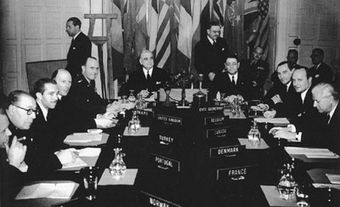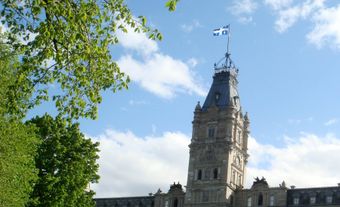Throughout its history, Canada has taken a series of steps to develop from a British colony into an independent nation. Both the First and Second World War were turning points; Canada’s military sacrifices gave it the strength and confidence to demand its own voice on the world stage. In the postwar era, Canada maintained its role in both Western and global alliances. (See NATO; NORAD; GATT.) However, economics have shaped Canadian diplomacy to a remarkable extent. Because of the United States’ singular importance to Canadian security and trade, relations with the US have dominated Canada’s foreign policy since Confederation.
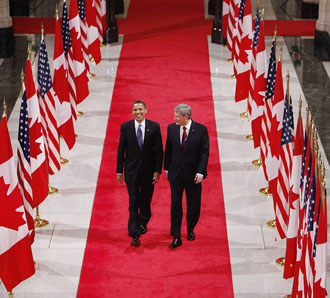
Confederation and Foreign Affairs
The colonies that united in Confederation were essentially self-governing in internal affairs. The British North America Act (now called the Constitution Act, 1867) gave legal force to the union; but it said nothing about foreign relations. It was assumed that those relations were the exclusive concern of the British government. The authorities then conducting Canada’s business with the United States were the governor general, the British ambassador in Washington and the British foreign secretary in London. The governor general consulted his Canadian ministers and transmitted their views to London; but final authority rested with the British government. ( See also Colonial Office.)
Early Relations with the United States
The Canadian government only gradually acquired influence over the country’s relationship with the United States. An important landmark was the Treaty of Washington in 1871. It resolved dangerous issues between Britain and the US left over from the American Civil War. In developing the treaty, the British government delegated Prime Minister John A. Macdonald as one of its five negotiators. This recognized both Canada’s growing status and its concern with the issues. However, Macdonald was present as a British delegate, not as a representative of his country.
Macdonald had serious disagreements with his British associates, particularly over the Atlantic fisheries. Though Macdonald was unhappy with this aspect of the treaty, he signed it. The treaty was advantageous to Canada in other ways, because it restored friendly relations between the British Empire and the US.

In 1874, the Liberal government of Prime Minister Alexander Mackenzie asked Britain to accredit George Brown (along with the British ambassador in Washington) to seek a reciprocity treaty similar to that of 1854, which the US had terminated in 1866. Macdonald and his colleagues had tried for this in 1871, without success. Brown failed likewise. Macdonald, after returning to power in September 1878, enacted the National Policy. Tariff reciprocity with the US continued to be a Canadian goal. But successive American administrations gave no encouragement. Trade policy remained Canada’s most persistent problem with the US. Fishery troubles were a close second.
In 1880, with Britain’s reluctant consent, Alexander Galt was appointed Canadian high commissioner in London. In 1882, a Canadian commissaire général was appointed in Paris; he doubled as a representative of Quebec until 1912. However, he had no official diplomatic status. No further development of Canadian representation abroad took place until after the First World War. (See Treaty of Versailles; Canada and the League of Nations.)
Imperial Relations
In the latter part of Queen Victoria’s reign, British anti-imperialism (reflected in the withdrawal of British army garrisons from central Canada in 1870–71) had given way to support for the Empire; at least in English-speaking Canada. When British General C.G. Gordon’s forces were cut off in Khartoum, Sudan, in 1884, there was considerable demand in Canada for a contingent to go to Africa to assist the British. Macdonald deliberately damped this down. But when Britain sought to raise, at its own expense, a body of Canadian volunteers to help a rescue expedition find its way up the Nile River, no objection was made. (See Nile Expedition.)
The beginning of the South African War in 1899 raised more serious questions. Prime Minister Wilfrid Laurier’s Liberals were now in power in Canada. Quebec, the main source of Laurier’s political power, was largely unmoved by the imperial enthusiasm of other provinces. On the question of contributing a contingent of soldiers, Cabinet was deeply divided. Ultimately, Laurier was forced by the majority to send a battalion of volunteers.
Further volunteer contingents followed. By the end of the conflict in 1902, Canadian troops had distinguished themselves in a foreign war for the first time. This fuelled an emerging sense that Canada could and should speak with an independent voice on the world stage.

Reciprocity and Alaska Boundary Dispute
Relations with the US continued to turn largely on commercial policy. In 1888, while in opposition, the Laurier Liberals had adopted “Unrestricted Reciprocity.” They fought and lost the election of 1891 — Macdonald’s last victory — on this issue. Thereafter, the Liberals abandoned unrestricted reciprocity. When they finally took power under Laurier in 1896, the government would eventually come to grief over reciprocity. But first, Laurier had to confront the Alaska Boundary Dispute. This old controversy acquired new importance during the Klondike Gold Rush.
The handling of the dispute by US President Theodore Roosevelt aroused bitter resentment in Canada; as did the behaviour of British representative Lord Alverstone, who voted with the Americans. Nevertheless, as with the Treaty of Washington, this settlement served Canada’s paramount interest; it removed an obstacle to friendly relations between the British Empire and the US.

Naval Controversy
Canada’s relationship with the British Empire found a focus in the series of Colonial and Imperial Conferences (1887–1937). The first was held in London in 1887. During the government of British Prime Minister Lord Salisbury (1895–1902), the colonial secretary was the energetic Joseph Chamberlain. He envisaged an Empire that was more organized and centralized.
In Laurier, Chamberlain met a determined defender of the status quo. Laurier regularly declared that Canada was satisfied with things as they were and had no demands to make. Canada had its autonomy and intended to keep it. After the turn of the century, the menace presented by the growing German navy led to demands both in Canada and Britain for some Canadian naval assistance. Laurier’s response was not a contribution to the Royal Navy but the beginnings of an autonomous Canadian navy. It was made possible by the Naval Service Act of 1910.
The general election of 1911 turned on foreign policy to an unprecedented extent. Any naval policy was unpopular in Quebec. Robert Borden, the Conservative leader, played down the issue during the campaign; he did not wish to expose divisions among his own supporters. Meanwhile, the Naval Service Act did Laurier much harm in Quebec.
Foreign Policy and the 1911 Election
The second biggest election issue that year was reciprocity with the US. The agricultural West had been pressing for freer trade. There was similar agitation in the US. The result had been the 1911 reciprocity agreement; it provided for free trade in a wide range of agricultural products and a limited number of manufactured goods. Violent nationalistic opposition developed against this measure. Manufacturers assailed it as a menace to Canadian industry. It was claimed that it would open the door to political union with the US. Laurier lost the election, and Borden became prime minister.
English-speaking Ontario now succeeded Quebec as the main seat of the government’s political power. Foreign policy reflected this fact. Laurier had sought to stand aside from imperial entanglements and had asserted no claim to influence in the imperial system. Borden, on the other hand, was prepared to participate but tried to exact a price. In England in 1912, he told British statesmen that Canadians would now expect “a voice” in forming imperial policy. Later that year, he proposed that Canada could contribute three battleships to the Royal Navy; he clearly expected a quid pro quo in the form of such influence. Britain’s Liberal government was loath to commit itself. The Canadian Senate, still controlled by the Liberals, rejected Borden's naval contribution bill.

First World War
Everything changed with the outbreak of the First World War. Canada was automatically at war when Britain went to war against Germany and Austria-Hungary. Most of Canada was united behind the decision of Borden’s government to actively support Britain with a Canadian Expeditionary Force. Over the next four years, nearly 61,000 Canadians died overseas. The country’s soldiers distinguished themselves at battlefields such as Ypres, the Somme, Vimy Ridge, and Amiens. Such sacrifice presented a stronger argument than ever before for a Canadian “voice” in the making of foreign policy. From 1914 to 1916, however, British Prime Minister H.H. Asquith still had nothing to offer.
In December 1916, Asquith was replaced as British prime minister by David Lloyd George. He realized that Canada, Australia and the other Dominions of the Empire could not be expected to continue making sacrifices without being called to Britain’s councils. He therefore summoned Dominion leaders to an Imperial War Cabinet and an Imperial War Conference. (See Colonial and Imperial Conferences.) It first met in March 1917. There, they discussed both the conduct of the war and imperial matters generally.
In April 1917, the Conference passed Resolution IX. Largely Borden’s work, it placed on record the opinion that any postwar adjustment of constitutional relations “should be based upon a full recognition of the Dominions as autonomous nations of an Imperial Commonwealth,” and should give the Dominions and India “an adequate voice in foreign policy.” The word Commonwealth was increasingly used to describe the self-governing (and later independent) parts of the British Empire.

Borden and the Paris Peace Conference
In 1918, the Imperial War Cabinet and War Conference met again for a second set of sessions. Borden was also active in these. In 1919, the Imperial War Cabinet in effect became the British Empire delegation to the Paris Peace Conference at the end of the war. Largely thanks to Borden’s insistence, the Dominions were accorded what amounted to dual representation in Paris; as nations in their own right and as units of the British Empire.
In both capacities, Canada signed the Treaty of Versailles. It also became a member of the League of Nations; its covenant was part of the Treaty. Thus, Canada acquired a new international status. It was won by its soldiers on the battlefield and confirmed by its statesmen’s strong efforts at the conference table.
Department of External Affairs
A small Department of External Affairs had been created in Ottawa by statute in 1909. Its principal mandate was to ensure the businesslike conduct of the country’s foreign concerns. In 1912, an amendment made the prime minister secretary of state for external affairs. This arrangement lasted until 1946.
For many years, the department’s most important official was Loring C. Christie. He was appointed by Borden in 1913 with the title of legal adviser. He was Borden’s confidential assistant at the Imperial War Cabinet and the Paris Peace Conference. He was a major contributor to the national achievements of the period. When Borden retired in July 1920 and Arthur Meighen became prime minister, Christie remained as Meighen’s trusted adviser.

Imperial Conferences of 1921 and 1922
Arthur Meighen represented Canada at the Imperial Conference of 1921. This conference proceeded on the assumption that it was best for the Empire to pursue a common foreign policy arrived at by consultation. Difficulties arose, however, over the renewal of the Anglo-Japanese alliance. Meighen, influenced by Christie, argued that the alliance constituted a serious obstacle to amicable relations with the US, so vital to the Empire and particularly to Canada. Australia, on the other hand, regarded the alliance as important to its security.
A disastrous break was avoided by Lloyd George’s diplomatic tactics; at the subsequent Washington Conference of 1922 (attended by Borden and Christie), the Anglo-Japanese alliance was abandoned. It was replaced by a four-power treaty signed by Britain, the US, Japan and France; the countries agreed to respect one another’s rights and possessions in the Pacific. This conference was the last important occasion when a British Empire delegation functioned as a unit at an international negotiation.
Mackenzie King and Canadian Autonomy
In the December 1921 general election, Meighen was defeated by Prime Minister William Lyon Mackenzie King’s Liberals. Foreign policy was not a major issue in the election. But the outcome changed Canada's foreign policy even more than did the election of 1911. The Liberals took every one of Quebec’s 65 seats in the House of Commons; it was inevitable that King’s policies should be tailored accordingly. In 1921, Quebec was strongly isolationist. The war and conscription had left deep marks. (See also Wartime Elections Act.) The result was the abandonment of unified diplomacy in partnership with the other countries of the Commonwealth. Instead, a separate national foreign policy was adopted.
At the Paris Peace Conference, Canada had been recognized both as a member country of the British Empire and as a separate nation. King’s policies consistently emphasized the separate nation aspect at the expense of the imperial aspect. Christie was frozen out of the Department of External Affairs in 1923 and lost his influence. His successor as the prime minister’s confidential advisor was O.D. Skelton. He became undersecretary in 1925; he held that appointment until his death in 1941.
Skelton was not the deviser of King’s policies; they were well developed before Skelton joined him. Nor were their opinions the same. King was an admirer of British institutions and practices. Unlike Skelton, he always considered that Canada would have to stand by Britain in another world war. But King and Skelton entirely agreed in rejecting a common foreign policy for the Commonwealth. They maintained that, in normal conditions, Canada and Britain should pursue their own policies.
The Chanak Affair of 1922, with its bungled British request for a Canadian expeditionary force, had provided a convincing background for King’s attitude. He had also given a striking example of his view of policy; in March 1923, he insisted that the Halibut Treaty with the US be signed by Canada alone, without British participation. He was delighted when the 1923 Imperial Conference accepted this procedure as normal.

Canada’s First Diplomatic Offices
Under Mackenzie King, Canada achieved separate diplomatic representation in Washington. An arrangement for this had in fact been made during Borden’s tenure; but no action had been taken. In 1927, Vincent Massey became the first Canadian envoy to the US with full diplomatic status. Legations were also opened in France in 1928 and Japan in 1929. Early in 1939, missions were established in Belgium and the Netherlands (served by the same envoy). This was the extent of Canadian representation abroad before the Second World War. (See also Diplomatic and Consular Representations.)
Canada’s relations with the League of Nations began at Paris in 1919 with an effort to weaken Article 10 of the covenant; it bound members to defend the territorial integrity and independence of all other members. Successive Canadian governments continued to fight against this article (which was especially unpopular in Quebec) until 1923. That year, a resolution was put forward; it left to each member the decision as to how far it was bound to use force in fulfilment of Article 10. The resolution failed to produce the unanimous support required for adoption by only one vote. This damaged the idea that international security was now a collective responsibility.
In 1927, Canada was elected to a non-permanent seat on the League Council. Mackenzie King reluctantly agreed to this. He feared unnecessary commitments and complications.
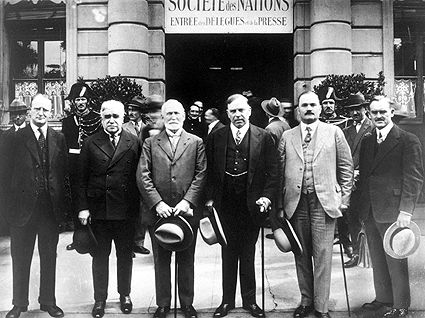
Statute of Westminster
The Imperial Conference of 1926 resulted in a formal widening of Dominion autonomy. South Africa insisted that Britain’s relation with the Dominions be defined. The result was the Balfour Report. It led to the 1931 Statute of Westminster, which gave the Dominions complete legislative independence so far as they desired it. In Canada’s case, this stopped short of the right to amend its own constitution, the core of which was found in the 1867 British North America Act.
This reservation was the result of pressure from Ontario and Quebec. It ended only with the Constitution Act, 1982. The word “independence” is not found in the Statute of Westminster; Mackenzie King would not hear of it in the discussions of 1926. But Canada’s full independence may be said to date from that statute, on 11 December 1931. (See Editorial: The Statute of Westminster, Canada’s Declaration of Independence.)
Bennett and the Great Depression
By this time, the Great Depression had brought Prime Minister R.B. Bennett to power in the 1930 election. Motivated by the desperate state of the economy, Bennett raised the import tariff; this was mainly in retaliation for the new American Hawley-Smoot tariff. Rates for British imports into Canada were also raised. At the Imperial Conference of 1930, Bennett made a dramatic gesture; he invited the delegates to a special economic conference in Ottawa and proposed a 10 per cent increase in rates levied against countries outside the Commonwealth.
British politicians saw how little the offer was worth; nevertheless, the Imperial Economic Conference finally met in Ottawa in 1932. The hope was that something might be done to alleviate the Depression. (See also Ottawa Agreements.) Bennett, theoretically an imperialist, was in fact an economic nationalist of the first order. The Anglo-Canadian trade agreement made at the Conference contained some concessions on both sides. But the achievement was much less than optimists had hoped. There was also ill will between British and Canadian negotiators.

Second World War
As the general election of 1935 approached, the international situation was worsening. Hitler had come to power in Germany in 1933; Japan was engaged in aggression against China; and Italy was preparing to attack Ethiopia. The League of Nations’ effort to restrain Italy led to worries about an Anglo-Italian war. As a result, Britain and France — and Canada too — scurried away from concerted action to save Ethiopia.
After the 1935 election returned the Liberals to power, Prime Minister Mackenzie King adopted a policy of economic conciliation. This put an end to a trade war with Japan and (more important) resulted in a trade agreement with the US; something Bennett had pursued without success.
Mackenzie King supported the British policy of appeasement toward Hitler and Germany, sacrificing Czechoslovakia in the process. But ongoing Nazi aggression, including Germany’s attack on Poland in 1939, made it clear to King and his British counterpart that war was inevitable. Unlike in the First World War, Canada was not automatically at war when Britain declared war on Germany. On 9 September 1939 — a week after Britain and France’s own declarations — the Canadian Parliament formally approved going to war against Germany. (See Second World War.)
At first, Mackenzie King was cautious about committing Canadian forces to combat overseas; largely because he feared a repeat of the conscription crisis that nearly tore the country apart in the First World War. From 1939 to 1941, Canada contributed material supplies, air training and naval escort resources to the Allied war effort. By the end of 1941, however, Canadian soldiers were fighting on the ground against the Japanese in Hong Kong. In 1942, Canadians were engaged against the Germans in Europe. (See Dieppe Raid.) By the end of the war in 1945, more than a million Canadians had served in uniform and more than 43,000 had been killed. Despite this enormous contribution, King and other Canadians did not play a significant role among the Allied leaders of the US, Britain and the Soviet Union in determining the direction of the war. (See also Mackenzie King and the War Effort.)
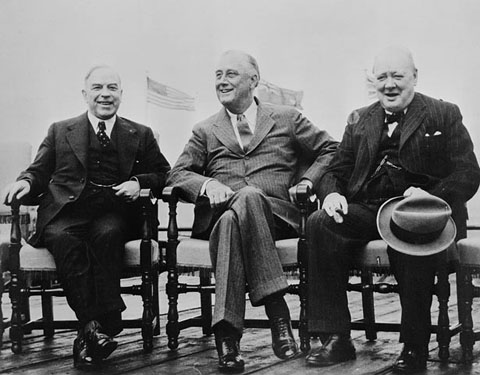
Leaders Prime Minister William Lyon Mackenzie King, American President Franklin D. Roosevelt, and British Prime Minister Winston Churchill at the first Quebec Conference in August 1943.
Post-War Confidence and Internationalism
Even so, by 1945 Canada had become an economic and military power of considerable size. The Department of External Affairs was expanding. Its diplomats were internationalists; unlike so many Canadians of the 1920s and 1930s, they did not reject foreign involvement. A sense was emerging that Canada, because of its wartime sacrifices, was owed a share in international decision-making. There was also a belief that, because of Canada’s status as a middle power, the Great Powers would completely disregard the country if it was unrepresented in international councils. Canadians were finally ready to take an active role in the world.
In 1946, the office of secretary of state for external affairs was finally separated from that of the prime minister. The first such secretary of state under this new regime was Louis St-Laurent. Mackenzie King’s retirement from politics in November 1948 was the end of an era.
O.D. Skelton’s best legacy to the Department of External Affairs had been the group of able civil servants he recruited beginning in 1927; they included Lester Pearson, Norman Robertson and Hume Wrong. The professional standard established by these men and their colleagues was a great asset to a country beginning to make its way in diplomacy. Robertson became undersecretary in 1941, succeeding Skelton. Pearson succeeded Robertson in 1946. When St-Laurent was about to become prime minister, Pearson entered Cabinet as secretary of state for external affairs.
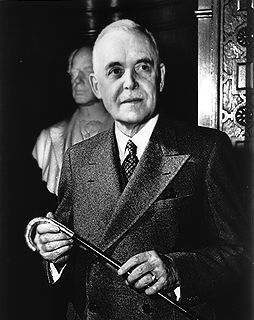
United Nations and NATO
The United Nations (UN) was the successor institution to the League of Nations. It held its founding conference in San Francisco in 1945. Faith in the UN’s effectiveness was undermined by the Cold War between the Soviet Union and the West. Canada not only accepted but advocated the idea of a western regional union for collective defence. The country signed the North Atlantic Treaty in 1949. As a result, Canadian military units were sent to Europe in 1951 to serve under the North Atlantic Treaty Organization (NATO). During the same period, Canada dispatched an army brigade group to fight under UN command in the Korean War. These commitments led to large increases in Canada’s Armed Forces.
Joining NATO marked a turning point in Canadian foreign policy. Traditionally, Canada had been loath to accept commitments either to Britain or the US individually. It was easier to accept commitments to an organization of which both were members. It was becoming clear, however, that the Second World War had greatly weakened Britain’s global position. It was also clear that confrontation between the superpowers — the capitalist US and the communist Soviet Union — was now the dominant feature of global politics. Relations with the American neighbour eclipsed all other Canadian external issues.

Commonwealth and the Suez Crisis
As Britain gave up its imperial obligations, the Commonwealth became increasingly multiracial. The Canadian government encouraged this development.
The new polity was severely strained in 1956 by the Suez Crisis. Britain and France launched a military attack on Egypt following Egyptian nationalization of the Suez Canal Company. The UN, including the US, condemned the aggression; it was also strongly condemned by the non-white Commonwealth countries. Canada abstained from voting on a resolution demanding a cease-fire and Anglo-French withdrawal. Instead, it proposed the intervention of an international peacekeeping force.
The Commonwealth stayed together. Lester Pearson received the Nobel Peace Prize for his peace initiatives in the Suez Crisis. Canada was at the height of its diplomatic influence.

John Diefenbaker
The election of 1957 brought the Progressive Conservatives under Prime Minister John Diefenbaker to power. During his tenure, until 1963, foreign relations turned largely on the military connection with the US. At the very beginning, the new government decided Canada would join the US in the North American Aerospace Defence Command (NORAD).
Diefenbaker’s personal relations with US President John F. Kennedy (1961–63) were poor. (See Cuban Missile Crisis.) And there was trouble over whether Canada should accept American nuclear weapons. (See Bomarc Missile Crisis.) In 1963, Pearson, as Opposition leader, reversed his earlier stand and said Canada should accept the nuclear weapons in order to carry out its obligations to the US. Diefenbaker’s vacillations on the subject led to resignations from his Cabinet, and finally to his government’s electoral defeat.

Lester Pearson
Under Prime Minister Lester Pearson, Canadian-American relations were less acerbic than under Diefenbaker. However, US participation in the Vietnam War caused a good many Canadians to question the morality and good sense of the Americans. A positive development of 1965 was the so-called Autopact (Canada-US Automotive Products Agreement). It established free trade between the two countries in motor vehicles and parts. One result was that large numbers of cars were produced in Canada for sale in the US. (See also Manufacturing in Canada.)
The broad strokes of Canadian foreign policy changed little under Pearson; as Canada’s chief diplomat since the Second World War, he had done so much to lay them down. The main lesson learned from the country’s experience in that conflict — that security was best ensured by a strong and united West — was still accepted and encouraged.

Pierre Trudeau
With Pearson’s retirement in 1968 and his replacement as prime minister by Pierre Trudeau, there was a change of atmosphere. Trudeau was not, like Pearson, a member of the Ottawa establishment. He had also played no part in the war. The Prime Minister’s Office (PMO) became more important and the Department of External Affairs less influential. In 1969, there was a drastic reduction in the Armed Forces and a considerable reduction in the size of the foreign service. Later under Trudeau, Canada reduced its military commitments to NATO.
The cut in military strength contributed to a decline in Canadian diplomatic influence; though this was already in progress due to the postwar recovery of France and West Germany. In 1970, a series of government pamphlets entitled Foreign Policy for Canadians defined Canada’s goals; they were to “foster economic growth, safeguard sovereignty and independence, work for peace and security, promote social justice, enhance the quality of life, [and] ensure a harmonious natural environment.” These high-sounding phrases struck traditional diplomatists as hardly a practical basis for foreign policy. Some feared they were signs of a new isolationism; especially taken with the measures of 1969.
In fact, Trudeau pursued not isolationism, but a more independent path for Canada in the world. In 1982, his government completed the unfinished business of Canadian independence by “patriating” the Canadian Constitution; transferring the country’s highest law — the Constitution — from the authority of the British parliament to that of Canada. The British North America Act, a remnant of the colonial past, was updated with the Constitution Act, 1982. It also included the Canadian Charter of Rights and Freedoms.
Trudeau maintained Canadian membership in NATO, the Group of Seven leading industrialized nations (G7) and other Western-leaning institutions. However, he also sought closer ties to the Soviet Union; pursued a friendship with Cuban dictator Fidel Castro; and gave diplomatic recognition to communist China long before other Western allies. Trudeau was willing to irritate American presidents, and he often did. As he once aptly explained in a speech in Washington, DC, being America’s closest neighbour is like “sleeping with an elephant… one is affected by every twitch and grunt.”

US President Richard Nixon and Prime Minister Pierre Trudeau at the Parliament Building in Ottawa, 14 April 1972.
Canadian-American Economic Relations
Economic relations with the US have been arguably Canada’s most important foreign policy concern since the end of the Second World War. This area provided some of the worst problems of the Trudeau era. There was considerable anti-Americanism; it was sparked by resentment of US influence and by increasing dislike of the Vietnam War. Energy problems, following an oil crisis caused by the Organization of Petroleum Exporting Countries (OPEC) in 1973–74, caused friction between Canada and its neighbour. This was largely due to the domination of the Canadian oil market by American companies.
In 1980, the Trudeau government announced the National Energy Program (NEP). One of its goals was to have at least 50 per cent Canadian ownership of oil and gas production by 1990. But this coincided with the election of US President Ronald Reagan. To his conservative Republican administration, the NEP was an object of hostility; it was also much hated by the US oil companies. So was another Trudeau institution; the federal Foreign Investment Review Agency. It began to monitor foreign investment in Canada in 1974.
Before the Second World War, Canada had two great trading partners: Britain and the US. Exports to Britain exceeded imports; with the US, the situation was the reverse. After the war, Canada’s British market never wholly revived. By the end of the 20th century, Japan was Canada’s second-largest trading partner. As of 2020, that position belonged to China. The US, however, still dominates Canadian trade. (See Canada-US Economic Relations.)
For years, Canadian trade policy has been influenced in the direction of freer trade by adherence to the General Agreement on Tariffs and Trade (GATT). It was first drawn up in 1947; it has been modified since. In recent decades, bilateral or regional free trade agreements have also been pursued, sometimes successfully, with the US; with other parts of the Americas; with Europe; and with the nations of the Pacific Rim.

US President Ronald Reagan meeting with Prime Minister Pierre Trudeau during working visit in Oval Office, 15 December 1983.
Brian Mulroney
Prime Minister Brian Mulroney’s Progressive Conservatives were elected to power in 1984. One of their main pledges was to “refurbish” the relationship with the US. It had been bruised by the many disputes under Trudeau. Mulroney cultivated his relationship with US President Reagan. The two leaders’ affinity was emphasized during Reagan’s visit to Quebec City (the so-called “Shamrock Summit”) in March 1985. The new approach led to the abandonment of the National Energy Program and the weakening of the Foreign Investment Review Agency, now to be called Investment Canada.
Mulroney and Reagan agreed to seek a comprehensive free trade agreement between their countries. Teams began negotiations; but 16 months of discussion failed to produce the desired result. The intervention of cabinet-level negotiators from both countries brought about an “agreement in principle” on 3 October 1987, within minutes of a deadline set by the US Congress. The final document was published on 11 December 1987.
The complicated arrangement called for the elimination of all bilateral tariffs between Canada and the US over 10 years. The deal had a mixed reception in Canada. Business interests in general favoured it; organized labour opposed it. The West in general was broadly favourable. The Quebec government supported it and Atlantic Canada seemed uncertain about it; but Ontario was officially hostile.
The 1988 federal election was fought on the issue. Polls showed that a majority of Canadians opposed the measure; but the anti-free trade vote was split between the Liberals and the NDP. As a result, Mulroney won a decisive victory. He formed a new government and pushed free trade legislation through Parliament by year’s end. In 1993, just before Mulroney left power, the Canada-US Free Trade Agreement (FTA) was extended to the North American Free Trade Agreement (NAFTA) with the inclusion of Mexico.
The Mulroney government was also enthusiastic about multilateral institutions, such as the G-7 and the Organization of American States; Canada joined the latter in 1990. In the aftermath of the Cold War, the Mulroney government argued strongly for an activist and even muscular UN. It supported efforts to drive Iraq out of Kuwait in 1990–91; as well as peacekeeping efforts around the world. Some of these (as in Somalia and the former Yugoslavia) went far beyond the traditional role of monitoring ceasefire lines.
Mulroney and his external affairs minister, former Prime Minister Joe Clark, were also vocal in defence of human rights. Thanks to them, Canada was at the forefront of the fight against apartheid in South Africa; often against the wishes of governments in London and Washington. (See also Nelson Mandela: A Soft Spot for Canada.)

Jean Chrétien
Economics shape Canadian diplomacy to a remarkable extent. At the end of the 20th century, the Department of Foreign Affairs and International Trade (previously External Affairs) included both a foreign minister and a trade minister. Meanwhile, a major review of foreign policy published in 1995 placed employment, prosperity and economic growth at the centre of Canadian priorities. Pierre Trudeau had led international peace missions in 1983–84. This was at a time of heightened Soviet-American tensions. (See Cold War.) In the 1990s, Liberal Prime Minister Jean Chrétien instead led trade missions abroad, dubbed “Team Canada.” These were efforts to drum up commercial ties with Asia, Latin America and beyond.
In 1995, Chrétien began making deep cuts to the federal budget. Foreign aid was reduced by more than 20 per cent over three years. However, the Chrétien government — via Foreign Affairs Minister Lloyd Axworthy — was also a leader in the global campaign to ban anti-personnel land mines; as well as in the creation of an International Criminal Court.
Chrétien’s government also supported a variety of UN peacekeeping missions, including to Rwanda before and after the 1994 genocide there. It also committed Canadian resources to the 1999 NATO bombing campaign in Kosovo. (See also Canadian Peacekeepers in the Balkans.)
During the terror attacks against the US in 2001, Canada gave refuge to hundreds of stranded commercial airliners and their passengers. Canada also participated in the US-led invasion of Afghanistan. However, the Chrétien government refused to give Canadian support to the subsequent US invasion of Iraq.

A Canadian soldier, on United Nations peacekeeping duty in the former Yugoslavia in the early 1990s.
Stephen Harper
The election of Conservative Prime Minister Stephen Harper in 2006 brought a renewed commitment to the Canadian combat mission in Afghanistan. It had been started by Chrétien and strengthened by Prime Minister Paul Martin. The war in Afghanistan, along with its financial and human toll, dominated foreign policy through most of the Harper years.
At the same time, the Harper government realigned Canada in several ways on the world stage. Harper pursued a more hardline, pro-security agenda than his Liberal predecessors. He travelled frequently to the Arctic to assert Canadian sovereignty there. He offered staunch support to Israel at the expense of its Arab neighbours in the Middle East. His government gave scant support to international climate change efforts and even less to the United Nations. This may have cost Canada a temporary seat on the UN Security Council in 2010. The Harper government was also publicly critical of the communist regime in China; at least until business concerns persuaded Harper to restore more friendly relations in the interests of trade. He was also strongly critical of Russian aggression in Ukraine.
Under Harper, Canada pursued free trade deals in Latin America and Europe; some of them were only ratified after his defeat and departure from office in 2015.
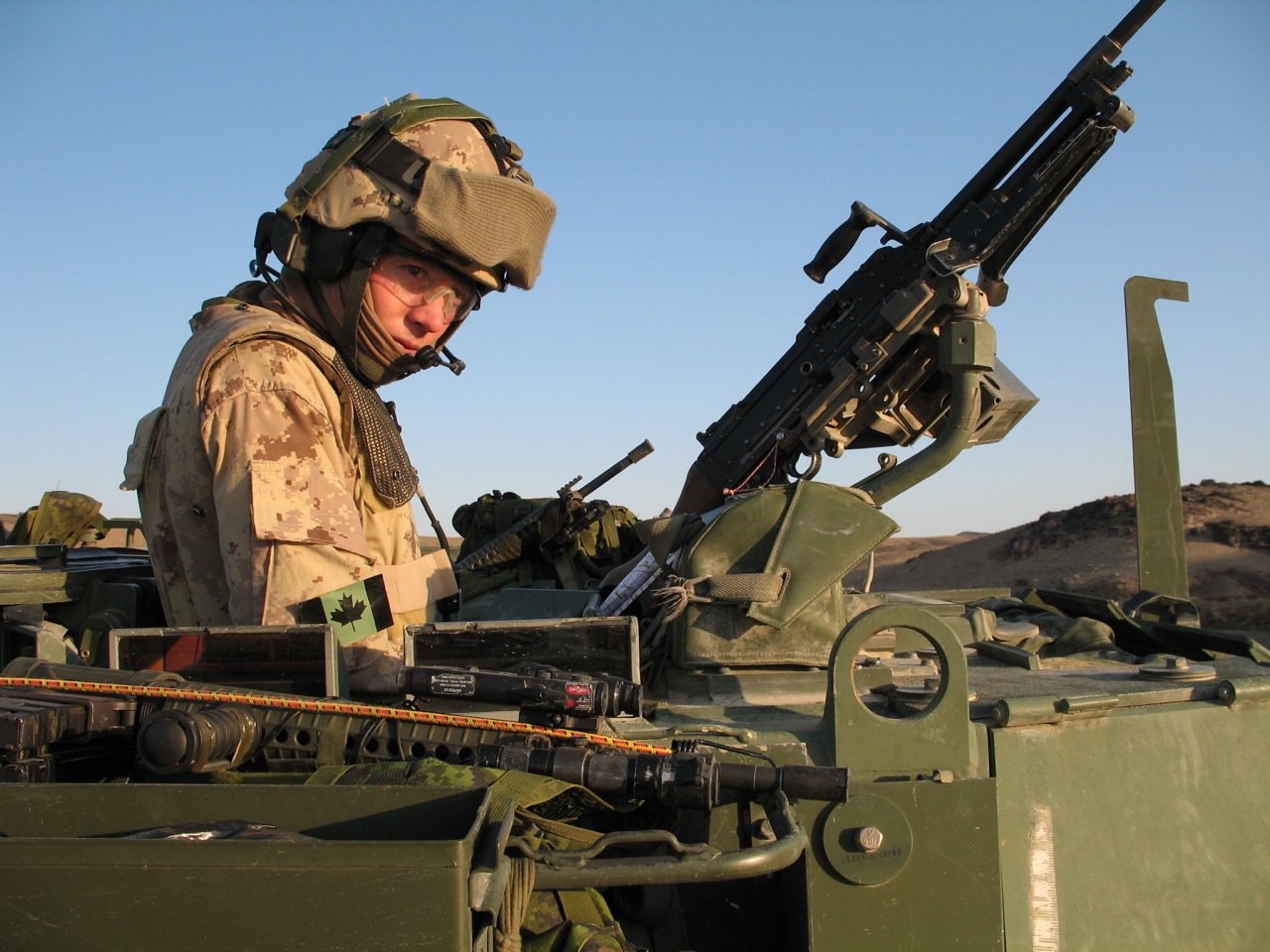
From 2001-2014 Canadian soldiers served with an international coalition fighting the war in Afghanistan — a legacy of the 9/11 attacks.
Justin Trudeau
The 2015 election of the Liberals under Prime Minister Justin Trudeau signalled Canada’s return to multilateralism. It actively re-engaged with international climate change agreements; as well as with the United Nations, NATO, the G7 and the G20. The Department of Foreign Affairs and International Trade was renamed Global Affairs Canada (GAC).
Trudeau’s government took an explicitly feminist approach to foreign policy and international development. It followed the lead of a 2015 economic theory espoused by the McKinsey Global Institute; that “advancing women’s equality can add $12 trillion to global growth.” The Feminist International Assistance Policy (FIAP) was introduced in June 2017. It promoted gender equality and the empowerment of women and girls. Trudeau’s Cabinet — one of only 10 in the world at the time to have gender parity — ensured that these priorities were also a key part of the agenda at the 2018 G7 Summit in Charlevoix, Quebec.

Chrystia Freeland, Canada’s Minister of Foreign Affairs, at the World Economic Forum Annual Meeting 2018 in Davos, Switzerland (25 January 2018)
Meanwhile, the election of Donald Trump as US President in 2016 made Canada-US relations more complex and challenging than ever. Trump’s protectionist approach to foreign policy resulted in trade wars with Canada on several fronts; he slapped tariffs on Canadian steel, aluminum, and lumber, and targeted the country’s supply management-supported dairy industry. He also followed through on his threats to renegotiate NAFTA and to seek greater military spending from America’s NATO partners. The result of the former was the Canada-United States-Mexico Agreement (CUSMA). A revised and renamed version of NAFTA, it came into force on 1 July 2020. CUSMA is expected to have only a modest impact on economic growth. However, it could have a major impact on the restructuring of the North American economy. It may also limit Canada’s policy options in moving to a new economy based on knowledge, data and intellectual property.
See also White Paper on Foreign Policy; Canadian Institute of International Affairs; Middle Power; Continentalism; Globalization; Foreign Aid.

 Share on Facebook
Share on Facebook Share on X
Share on X Share by Email
Share by Email Share on Google Classroom
Share on Google Classroom


